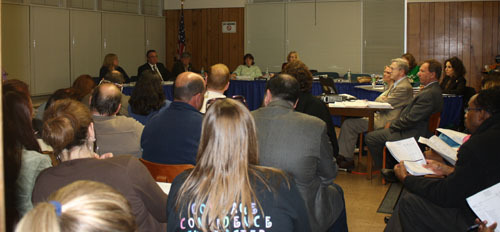School News
Baldwin school board to adopt proposed budget
Increasing some class size limits, cutting late buses likely in next year's spending plan
Posted
As of Wednesday afternoon, Baldwin school board officials were anticipating
raising the class size limit at elementary schools and eliminating high school late buses in an effort to keep expenditures down during a turbulent economic climate.
But with spending increases seen largely due to contractual obligations and not much elsewhere, the board was expected to adopt a spending plan for next year with a relatively low budget-to-budget increase of about 2.75 percent.
Officials are looking to increase the class size limit by one student — from 22 to 23 — for grades K-2; and by two students — 25 to 27 — for grades 3-5. That does not mean that all classes will have the maximum number of students, officials explained, because not all classes are at full capacity. The savings from this action would be approximately $1 million.
Board president Mary Jo O'Hagan said she understood residents' concerns about raising the class size limit, but added that trustees have worked hard to reduce spending responsibly. Changes could be made to the proposed budget up to March 24, O'Hagan explained, but the board's proposals were likely to stand unless a more viable plan was presented.
"We had to look at some very, very painful cost-cutting measures," she said. "We tried to select those that had the least impact on the quality of education."
How the state can help or hurt the district
How much the school board is able to reduce spending is partially dependent on New York state for several reasons.
While the district is slated to receive $25.78 million in state aid next year — as detailed in the governor's proposed executive budget — the precarious condition of Albany, both financially and politically, could delay the vote on the state budget well past its April 1 deadline. If that happened, the district may be forced to essentially guess at a state aid figure when putting its budget to a vote in May.
Also, the district's share of payment to the state teacher retirement system will increase by approximately $635,000 next year. District officials said that state legislation is pending to allow school districts to keep and use reserve funds to cover such increases in the future.
Also included in the district's proposed budget is about $200,000 to be paid for the Metropolitan Transportation Authority (MTA) tax. While the money is budgeted for next year, school districts have been promised a full state reimbursement of the tax by June 1.
And if the district budget is voted down...
The board has several options.
Trustees could take no action, and enter 2010-11 with what is known as a contingent budget. Because the consumer price index, or CPI, is negative this year, the contingent budget must show no increase in expenditures. To do that, the board would have to cut an additional $3 million in expenditures.
Or, the board could put up the failed budget a second time, hoping that those residents not taking part in the first vote would come out in force to ensure its
passage the second time around.
If the proposed budget were to fail twice, the district would have to move
forward with the contingent budget. But there are limits on what the board could spend money on.
For example, the district would not be permitted to make capital purchases, and private organizations would not be permitted to use school grounds.
“You are confined in the way you can spend money,” O’Hagan said.
Report an inappropriate comment
Comments






